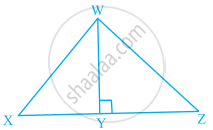Advertisements
Advertisements
प्रश्न
If the points A(−2, 1), B(a, b) and C(4, −1) are collinear and a − b = 1, find the values of a and b.
उत्तर
The given points are A (−2, 1), B (a, b) and C (4, −1).
Since the given points are collinear, the area of the triangle ABC is 0.
`=>1/2[x_1(y_2-y_3)+x_2(y_3-y_1)+x_3(y_1-y_2)]=0`
Here, `x_1=-2, y_1=1, x_2=a, y_2=b and x_3=4, y_3=-1`
`therefore 1/2[-2(b+1)+a(-1-1)+4(1-b)]=0`
-2b-2-2a+4-4b=0
2a+6b=2
a+3b=1 ........(1)
Given :
a-b=1 ..............(2)
Subtracting equation (1) from (2), we get:
4b=0
b=0
Substituting b = 0 in (2), we get:
a=1
Thus, the values of a and b are 1 and 0, respectively.
APPEARS IN
संबंधित प्रश्न
Prove that the points (a, b + c), (b, c + a) and (c, a + b) are collinear
Find the missing value:
| Base | Height | Area of triangle |
| 15 cm | ______ | 87 cm2 |
prove that the points A (7, 10), B(-2, 5) and C(3, -4) are the vertices of an isosceles right triangle.
If A(5,2), B(2, -2) and C(-2, t) are the vertices of a right triangle with ∠B=90° , then find the value of t .
Find the area of ΔABC whose vertices are:
A( 3,8) , B(-4,2) and C( 5, -1)
A(6,1) , B(8,2) and C(9,4) are the vertices of a parallelogram ABCD. If E is the midpoint of DC, find the area of ΔADE
Show that the following points are collinear:
A(5,1), B(1, -1) and C(11, 4)
If the centroid of ΔABC having vertices A (a,b) , B (b,c) and C (c,a) is the origin, then find the value of (a+b+c).
Area of a right-angled triangle is 30 cm2. If its smallest side is 5 cm, then its hypotenuse is ______.
Ratio of the area of ∆WXY to the area of ∆WZY is 3:4 in the given figure. If the area of ∆WXZ is 56 cm2 and WY = 8 cm, find the lengths of XY and YZ.

